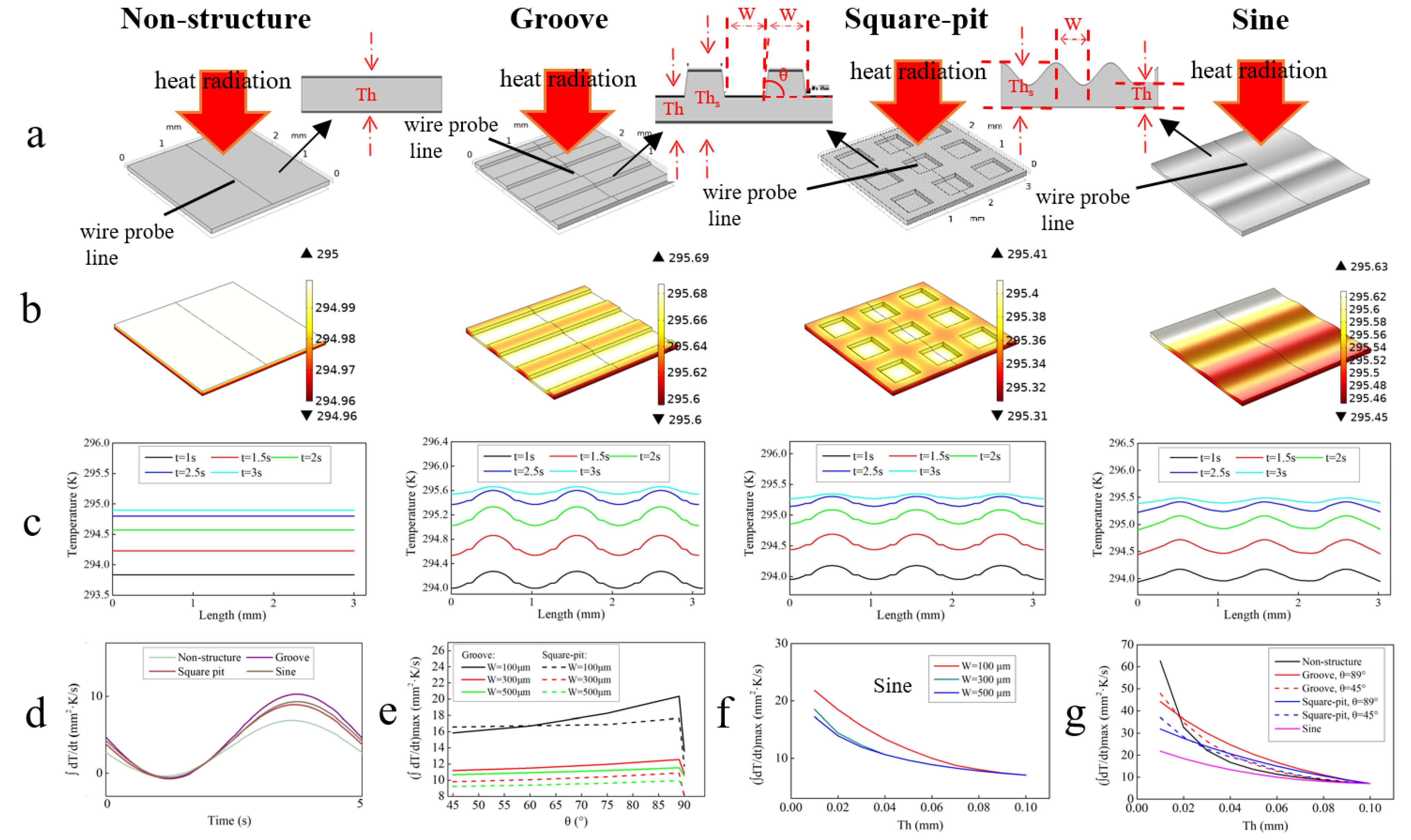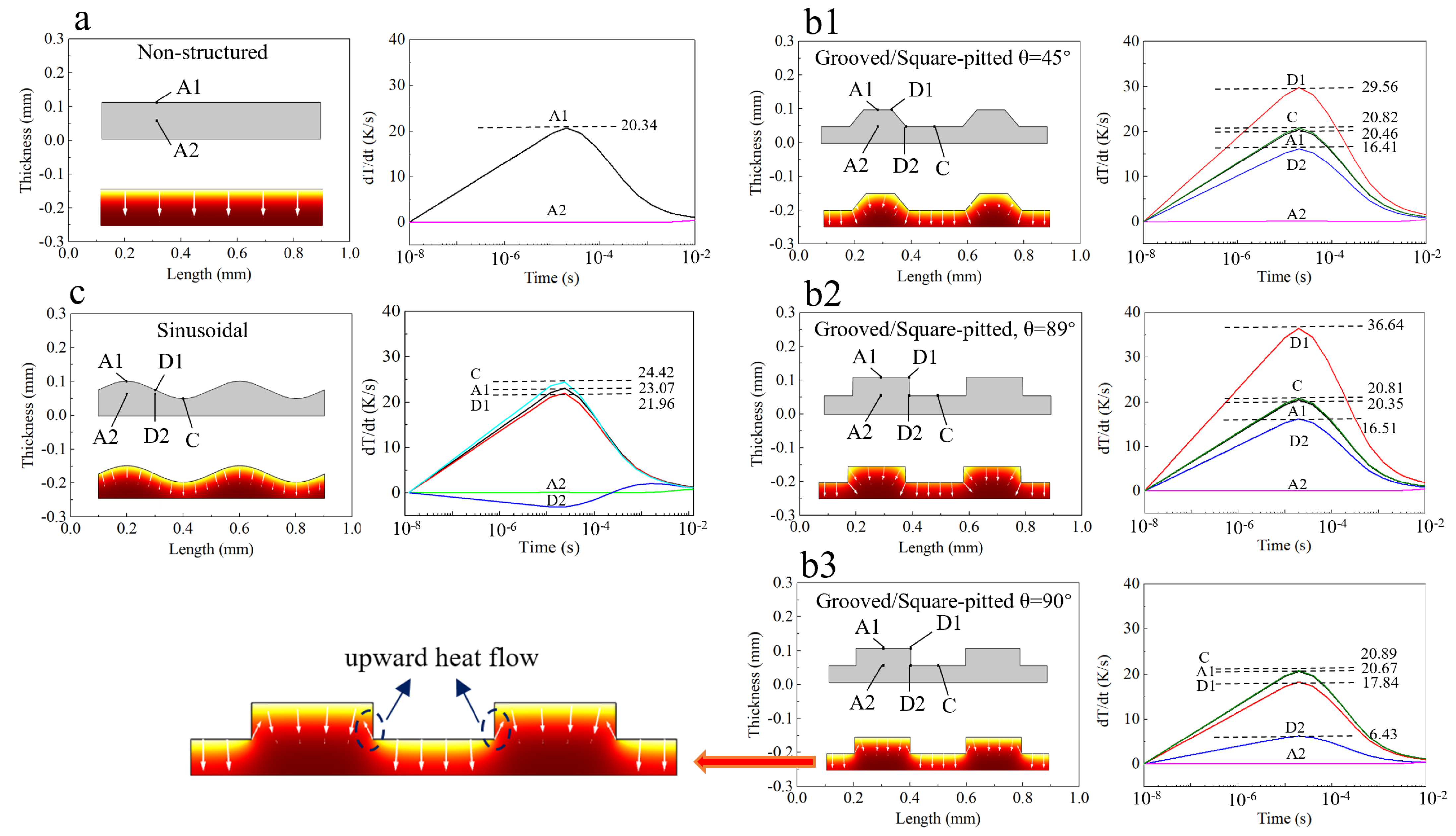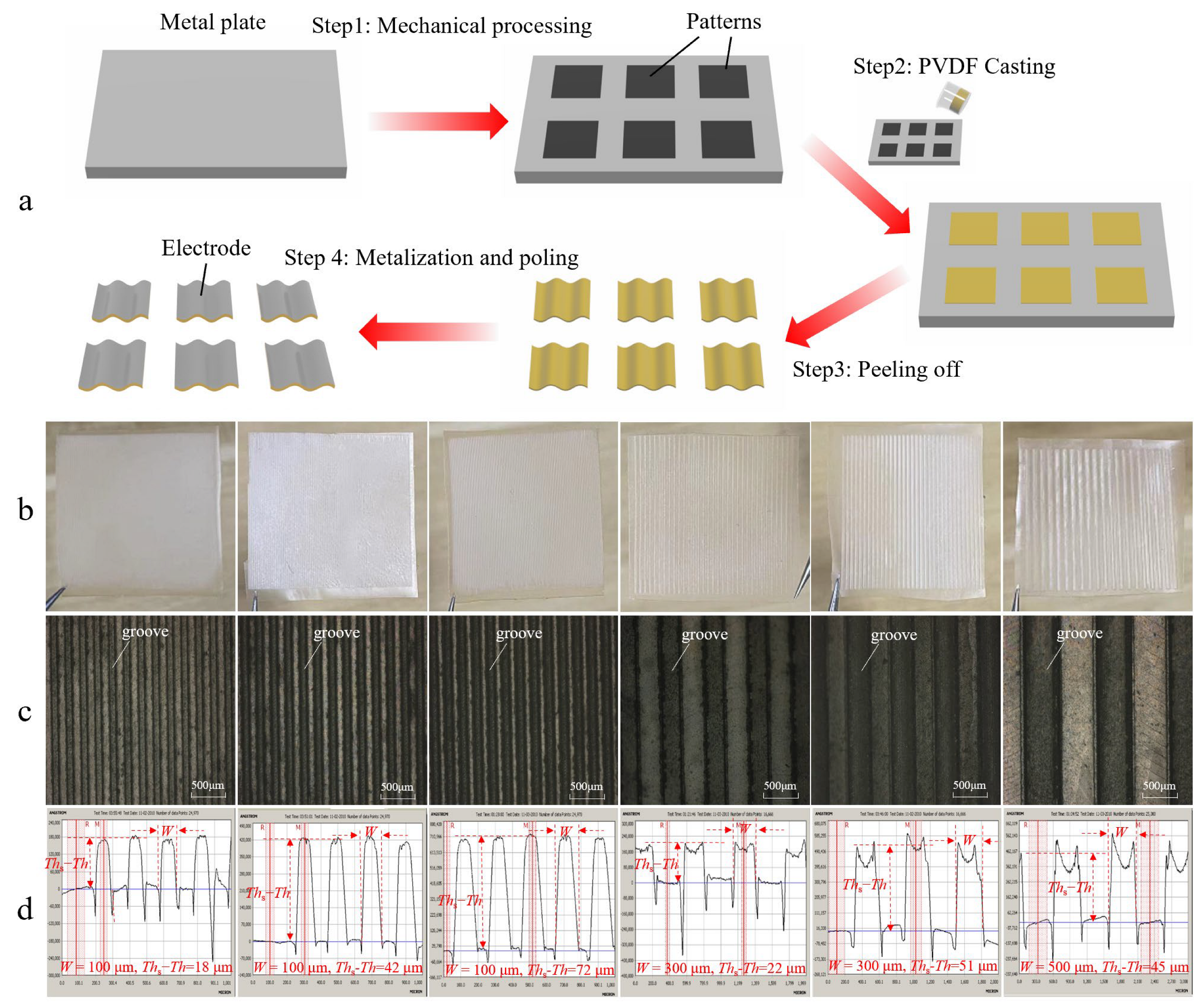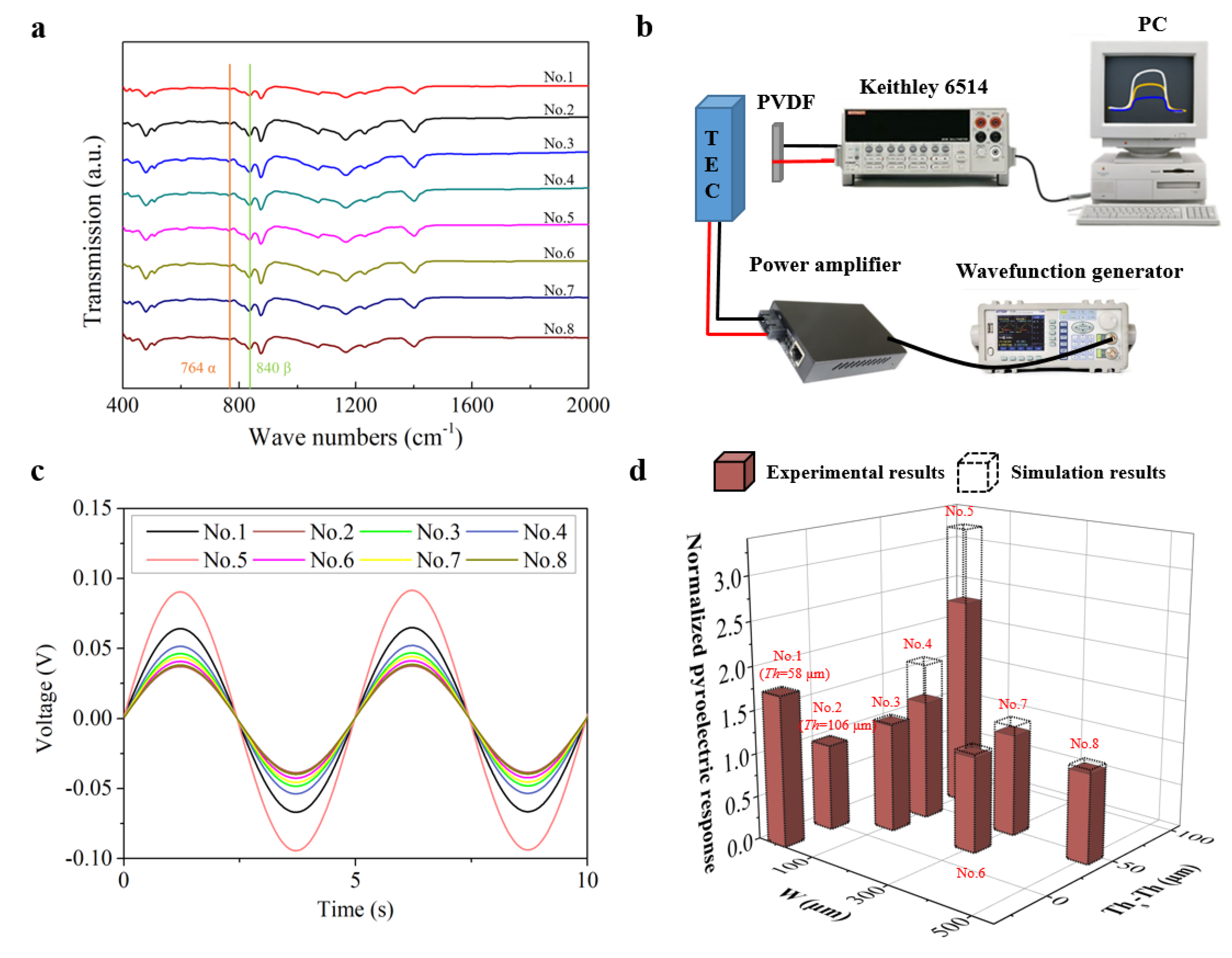Microstructured PVDF Film with Improved Performance as Flexible Infrared Sensor
Abstract
:1. Introduction
2. Finite Element Simulations and Discussion
3. Fabrication and Test of Microstructured PVDF Films
4. Conclusions
Author Contributions
Funding
Acknowledgments
Conflicts of Interest
References
- Porter, S.G. A brief guide to pyroelectric detectors. Ferroelectrics 1981, 33, 193–206. [Google Scholar] [CrossRef]
- Liu, S.T. Critical assessment of pyroelectric detectors. Ferroelectrics 1976, 10, 83–89. [Google Scholar] [CrossRef]
- Chen, B.L. Important applications of IRFPA imaging devices. Infrared Laser Eng. 2005, 34, 168–172. [Google Scholar]
- Chynoweth, A.G. Dynamic method for measuring the pyroelectric effect with special reference to barium titanate. J. Appl. Phys. 1956, 27, 78–84. [Google Scholar] [CrossRef]
- Putley, E.H. The possibility of background limited pyroelectric detectors. Infrared Phys. 1980, 20, 149–156. [Google Scholar] [CrossRef]
- Okuyama, M.; Togami, Y.; Hamakawa, Y.; Kimata, M.; Uematsu, S. Pyroelectric infrared-CCD image sensor using LiTaO3. Sens. Actuators 1989, 16, 263–271. [Google Scholar] [CrossRef]
- Banan, M.; Lal, R.B.; Batra, A. Modified triglycine sulphate (TGS) single crystals for pyroelectric infrared detector applications. J. Mater. Sci. 1992, 27, 2291–2297. [Google Scholar] [CrossRef]
- Bravina, S.L.; Morozovsky, N.V.; Morozovska, A.N.; Gille, S.; Salvestrini, J.P.; Fontana, M.D. Investigations of LiNbO3 and LiTaO3 single crystals for pyroelectric applications in the wide temperature range. Ferroelectrics 2007, 353, 202–211. [Google Scholar] [CrossRef]
- Tang, Y.; Zhao, X.; Feng, X.; Jin, W.; Luo, H. Pyroelectric properties of [111]-oriented Pb(Mg1/3Nb2/3)O3–PbTiO3 crystals. Appl. Phys. Lett. 2005, 86, 082901. [Google Scholar] [CrossRef]
- Tang, Y.; Wan, X.; Zhao, X.; Pan, X.; Lin, D.; Luo, H.; Sun, J.; Meng, X.; Zhu, J. Large Pyroelectric Response in Relaxor-Based Ferroelectric (1−x)Pb(Mg1/3Nb2/3)O3-xPbTiO3 Single Crystals. J. Appl. Phys. 2005, 98, 084104. [Google Scholar] [CrossRef]
- Chung, W.Y.; Sun, T.P.; Chin, Y.L.; Kao, Y.L. Design of pyroelectric IR readout circuit based on LiTaO3 detectors. In Proceedings of the 1996 IEEE International Symposium on Circuits and Systems, Atlanta, GA, USA, 15 May 1996; Volume 4, pp. 225–228. [Google Scholar]
- Lang, S.B.; Rice, L.H.; Shaw, S.A. Pyroelectric effect in barium titanate ceramic. J. Appl. Phys. 1969, 40, 4335–4340. [Google Scholar] [CrossRef]
- Li, H.Z.; Li, W.Z.; Yang, Y.J.; Tai, H.L.; Du, X.S.; Gao, R.Y.; Li, S.Y. Pyroelectric performances of 1-3 ferroelectric composites based on barium titanate nanowires/polyvinylidene fluoride. Ceram. Int. 2018, 44, 19254–19261. [Google Scholar] [CrossRef]
- Zhang, J.; Cole, M.W.; Alpay, S.P. Pyroelectric properties of barium strontium titanate films: Effect of thermal stresses. J. Appl. Phys. 2010, 108, 054103. [Google Scholar] [CrossRef] [Green Version]
- Mao, C.; Cao, S.; Yan, S.; Yao, C.; Cao, F.; Wang, G.; Yang, C. Pyroelectric response mechanism of barium strontium titanate ceramics in dielectric bolometer mode: The underlying essence of the enhancing effect of direct current bias field. Appl. Phys. Lett. 2013, 102, 242911. [Google Scholar] [CrossRef]
- Kesim, M.T.; Zhang, J.; Trolier-McKinstry, S.; Mantese, J.V.; Whatmore, R.W.; Alpay, S.P. Pyroelectric response of lead zirconate titanate thin films on silicon: Effect of thermal stresses. J. Appl. Phys. 2013, 114, 204101. [Google Scholar] [CrossRef] [Green Version]
- Hanrahan, B.; Sanchez, L.; Waits, C.M.; Polcawich, R.G. Improved pyroelectric performance for thin film lead zirconate titanate (PZT) capacitors with IrO2 electrodes. Smart Mater. Struct. 2015, 25, 015025. [Google Scholar] [CrossRef]
- Binnie, T.D.; Weller, H.J.; He, Z.; Setiadi, D. An integrated 16/spl times/16 PVDF pyroelectric sensor array. IEEE Trans. Ultrason. Ferroelectr. Freq. Control 2000, 47, 1413–1420. [Google Scholar] [CrossRef]
- Fujitsuka, N.; Sakata, J.; Miyachi, Y.; Mizuno, K.; Ohtsuka, K.; Taga, Y.; Tabata, O. Monolithic pyroelectric infrared image sensor using PVDF thin film. Sens. Actuators A 1998, 66, 237–243. [Google Scholar] [CrossRef]
- Franzan, A.H.; Leite, N.F.; Miranda, L.C.M. Investigation of poling field effects on PVDF pyroelectric detectors: Photoacoustic thermal diffusivity measurements. Appl. Phys. A 1990, 50, 431–438. [Google Scholar] [CrossRef]
- Neumann, N.; Köhler, R.; Hofmann, G. Pyroelectric thin film sensors and arrays based on P (VDF/TrFE). Integr. Ferroelectr. 1995, 6, 213–230. [Google Scholar] [CrossRef]
- Köhler, R.; Neumann, N.; Hofmann, G. Pyroelectric single-element and linear-array sensors based on P (VDF/TrFE) thin films. Sens. Actuators A 1994, 45, 209–218. [Google Scholar] [CrossRef]
- Setiadi, D.; Regtien, P.P.L.; Sarro, P.M. Application of VDF/TrFE copolymer for pyroelectric image sensors. Sens. Actuators A 1994, 42, 585–592. [Google Scholar] [CrossRef]
- Lu, K.; Huang, W.; Guo, J.; Gong, T.; Wei, X.; Lu, B.W.; Liu, S.Y.; Yu, B. Ultra-sensitive strain sensor based on flexible poly (vinylidene fluoride) piezoelectric film. Nanoscale Res. Lett. 2018, 13, 1–6. [Google Scholar] [CrossRef] [PubMed]
- Park, J.; Kim, M.; Lee, Y.; Lee, H.S.; Ko, H. Fingertip skin–inspired microstructured ferroelectric skins discriminate static/dynamic pressure and temperature stimuli. Sci. Adv. 2015, 1, e1500661. [Google Scholar] [CrossRef] [PubMed] [Green Version]
- Bhavanasi, V.; Kumar, V.; Parida, K.; Wang, J.; Lee, P.S. Enhanced piezoelectric energy harvesting performance of flexible PVDF-TrFE bilayer films with graphene oxide. ACS Appl. Mater. Interfaces 2016, 8, 521–529. [Google Scholar] [CrossRef]
- Tien, N.T.; Jeon, S.; Kim, D.I.; Trung, T.Q.; Jang, M.; Hwang, B.U.; Byun, K.E.; Bae, J.; Lee, E.; Tok, J.; et al. A flexible bimodal sensor array for simultaneous sensing of pressure and temperature. Adv. Mater. 2014, 26, 796–804. [Google Scholar] [CrossRef] [PubMed]
- Tien, N.T.; Seol, Y.G.; Dao, L.H.A.; Noh, H.Y.; Lee, N.E. Utilizing highly crystalline pyroelectric material as functional gate dielectric in organic thin-film transistors. Adv. Mater. 2009, 21, 910–915. [Google Scholar] [CrossRef]
- Trung, T.Q.; Ramasundaram, S.; Lee, N.E. Infrared detection using transparent and flexible field-effect transistor array with solution processable nanocomposite channel of reduced graphene oxide and P (VDF-TrFE). Adv. Funct. Mater. 2015, 25, 1745–1754. [Google Scholar] [CrossRef]
- He, X.; Wang, C.; Huang, X.; Jin, L.; Chu, X.; Xie, M.; Nie, Y.; Xu, Y.; Peng, Z.; Zhang, C.; et al. Carbon Nanolights in Piezopolymers are Self-Organizing Toward Color Tunable Luminous Hybrids for Kinetic Energy Harvesting. Small 2020, 16, 1905703. [Google Scholar] [CrossRef]
- Yu, X.; Liang, X.; Krishnamoorthy, R.; Jiang, W.; Zhang, L.; Ma, L.; Zhu, P.; Hu, Y.; Sun, R.; Wong, C.P. Transparent and flexible hybrid nanogenerator with welded silver nanowire networks as the electrodes for mechanical energy harvesting and physiological signal monitoring. Smart Mater. Struct. 2020, 29, 045040. [Google Scholar] [CrossRef]
- Zhou, Y.; Zhang, S.; Xu, X.; Liu, W.; Zhang, S.; Li, G.; He, J. Dynamic piezo-thermoelectric generator for simultaneously harvesting mechanical and thermal energies. Nano Energy 2020, 69, 104397. [Google Scholar] [CrossRef]
- Su, Y.; Li, W.; Yuan, L.; Chen, C.; Pan, H.; Xie, G.; Conta, G.; Ferrier, S.; Zhao, X.; Chen, G.; et al. Piezoelectric fiber composites with polydopamine interfacial layer for self-powered wearable biomonitoring. Nano Energy 2021, 89, 106321. [Google Scholar] [CrossRef]
- Yang, F.; Zhang, D.; Yu, B.; Zheng, K.; Li, Z. Pyroelectric properties of ferroelectric ceramic/ferroelectric polymer 0–3 composites. J. Appl. Phys. 2003, 94, 2553–2558. [Google Scholar] [CrossRef]
- Lam, K.S.; Wong, Y.W.; Tai, L.S.; Poon, Y.M.; Shin, F.G. Dielectric and pyroelectric properties of lead zirconate titanate/polyurethane composites. J. Appl. Phys. 2004, 96, 3896–3899. [Google Scholar] [CrossRef] [Green Version]
- Ploss, B.; Ng, W.Y.; Chan, H.L.W.; Ploss, B.; Choy, C.L. Poling study of PZT/P (VDF–TrFE) composites. Compos. Sci. Technol. 2001, 61, 957–962. [Google Scholar] [CrossRef]
- Hilczer, B.; Kułek, J.; Markiewicz, E.; Kosec, M. Pyroelectric response of PZT-PVDF nanocomposites of (0–3) connectivity. Ferroelectrics 2002, 267, 277–284. [Google Scholar] [CrossRef]
- Ploss, B.; Ploss, B.; Shin, F.G.; Chan, H.L.; Choy, C.L. Pyroelectric activity of ferroelectric PT/PVDF-TRFE. IEEE Trans. Dielectr. Electr. Insul. 2000, 7, 517–522. [Google Scholar] [CrossRef]
- Ningyl, Y.; Jinhua, L.; Chan, H.L.W. Properties of PT/P (VDF-TrFE) pyroelectric sensor based on plastic film substrate. Integr. Ferroelectr. 2002, 49, 265–273. [Google Scholar] [CrossRef]
- Zhang, Q.Q.; Ploss, B.; Chan, H.L.W.; Choy, C.L. Integrated pyroelectric array based on PCLT/P (VDF-TrFE) composite. Sens. Actuators A 2000, 86, 216–219. [Google Scholar] [CrossRef]
- Zhang, S.; Zhang, N.; Huang, C.; Ren, K.; Zhang, Q.M. Microstructure and electromechanical properties of carbon nanotube/poly (vinylidene fluoride—trifluoroethylene—chlorofluoroethylene) composites. Adv. Mater. 2005, 17, 1897–1901. [Google Scholar] [CrossRef]
- Zhang, Y.Y. Fundamental Research on Pyroelectric Composite Materials and Its Arrays. Ph.D. Thesis, Huazhong University of Science and Technology, Wuhan, China, 2012. [Google Scholar]
- Aggarwal, M.D.; Currie, J.R.; Penn, B.G.; Batra, A.K.; Lal, R.B. Polymer-Ceramic Composite Materials for Pyroelectric Infrared Detectors: An Overview; NASA Technical Memorandum: Washington, DC, USA, 2007. [Google Scholar]
- Surmenev, R.A.; Chernozem, R.V.; Pariy, I.O.; Surmeneva, M.A. A review on piezo-and pyroelectric responses of flexible nano-and micropatterned polymer surfaces for biomedical sensing and energy harvesting applications. Nano Energy 2021, 79, 105442. [Google Scholar] [CrossRef]
- Han, H.; Nakagawa, Y.; Takai, Y.; Kikuchi, K.; Tsuchitani, S.; Kosimoto, Y. Microstructure fabrication on a β-phase PVDF film by wet and dry etching technology. J. Micromech. Microeng. 2012, 22, 085030. [Google Scholar] [CrossRef]
- Zabek, D.; Taylor, J.; Bowen, C. Characterisation and Modelling of Meshed Electrodes on Free Standing Polyvilylidene Difluoride (PVDF) Films for Enhanced Pyroelectric Energy Harvesting. IEEE Trans. Sonics Ultrason. 2016, 63, 1681–1689. [Google Scholar] [CrossRef] [Green Version]
- Measurement Specialties, Inc. Piezo Film Sensors Technical Manual; Measurement Specialties, Inc.: Hampton, VA, USA, 2018; p. 3. [Google Scholar]
- Achaby, M.; Arrakhiz, F.Z.; Vaudreuil, S.; Essassi, E.M.; Qaiss, A. Piezoelectric β-polymorph formation and properties enhancement in graphene oxide—PVDF nanocomposite films. Appl. Surf. Sci. 2012, 258, 7668–7677. [Google Scholar] [CrossRef]





| Material | Density (kg/m3) | Thermal Conductivity (W/(m·K)) | Specific Heat Capacity (J/(kg·K)) |
|---|---|---|---|
| PVDF | 1780 | 0.15 | 1314 |
| Parameters | Non-Structured Samples | Grooved Samples | ||||||
|---|---|---|---|---|---|---|---|---|
| No. 1 | No. 2 | No. 3 | No. 4 | No. 5 | No. 6 | No. 7 | No. 8 | |
| W (μm) | - | - | 100 | 100 | 100 | 300 | 300 | 500 |
| Th (μm) | 58 | 106 | 90 | 79 | 48 | 90 | 81 | 92 |
| Ths (μm) | - | - | 108 | 121 | 120 | 112 | 132 | 127 |
| Ths − Th (μm) | - | - | 18 | 42 | 72 | 22 | 51 | 45 |
| Rs | 1.74 | 1 | 1.27 | 1.84 | 3.31 | 1.14 | 1.29 | 1.08 |
| Re | 1.70 | 1 | 1.28 | 1.43 | 2.46 | 1.14 | 1.17 | 1.07 |
| Rs − Re | 0.04 | 0 | −0.01 | 0.41 | 0.85 | 0 | 0.12 | 0.01 |
| Fβ | 74.36% | 73.31% | 66.58% | 68.90% | 70.15% | 74.43% | 76.60% | 80.24% |
Publisher’s Note: MDPI stays neutral with regard to jurisdictional claims in published maps and institutional affiliations. |
© 2022 by the authors. Licensee MDPI, Basel, Switzerland. This article is an open access article distributed under the terms and conditions of the Creative Commons Attribution (CC BY) license (https://creativecommons.org/licenses/by/4.0/).
Share and Cite
Guan, H.; Li, W.; Yang, R.; Su, Y.; Li, H. Microstructured PVDF Film with Improved Performance as Flexible Infrared Sensor. Sensors 2022, 22, 2730. https://doi.org/10.3390/s22072730
Guan H, Li W, Yang R, Su Y, Li H. Microstructured PVDF Film with Improved Performance as Flexible Infrared Sensor. Sensors. 2022; 22(7):2730. https://doi.org/10.3390/s22072730
Chicago/Turabian StyleGuan, Hongjian, Weizhi Li, Ruilin Yang, Yuanjie Su, and Hang Li. 2022. "Microstructured PVDF Film with Improved Performance as Flexible Infrared Sensor" Sensors 22, no. 7: 2730. https://doi.org/10.3390/s22072730




